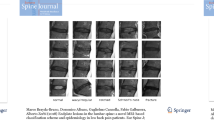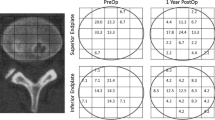Abstract
Purpose
To evaluate the morphology and location of vertebral endplate changes, and to analyze their association with age, gender, and body mass index (BMI).
Design and patients
At 1.5 T (T1-weighted, T2-weighted/STIR) 100 lumbar spines were evaluated separately by three observers. The readers classified the endplate bone marrow abnormalities on sagittal MR images according to the definitions of Modic et al. Findings were localized by disc segment; whether in the upper and/or lower endplate; and within each endplate divided into 15 segments. Disc space narrowing, as well as disc desiccation, was also noted at each vertebral level. In addition, endplate changes were correlated with age, gender, and BMI (weight(kg)/height(m)2).
Results
A total of 15,000 data points were studied and 422 total changes recorded. A total of 99 vertebral levels were affected in 58 patients. Of these, 171 were of type I, 242 were of type II, and 9 were of type III. L4―L5 and L5―S1 vertebral levels were most commonly involved, having (142, 4.73%) and (116, 3.87%) changes respectively (P<0.0001). The upper and lower aspects of the endplate were affected similarly. Changes most frequently occurred at the anterior aspect of the endplate (P<0.0001). Endplate marrow changes were associated with increasing age (P<0.0001) and, surprisingly, male gender (P<0.0001). Endplate changes were not associated with BMI.
Conclusion
The fatty pattern was most common, with the sclerotic pattern being rare. Endplate marrow changes most often occurred at the anterior aspect of the endplate, particularly at L4―L5 and L5―S1 levels. Modic changes occur more frequently with aging, evidence of their degenerative etiology. They were, however, not related to body habitus, but to weight and male gender.

Similar content being viewed by others
References
Jinkins JR. The postsurgical lumbosacral spine: magnetic resonance imaging evaluation following intervertebral disk surgery, surgical decompression, intervertebral bony fusion, and spinal instrumentation. Radiol Clin North Am 2001; 39:1–29.
Tehranzadeh J. Lumbar spine imaging: normal variants, imaging pitfalls, and artifacts. Radiol Clin North Am 2000; 38:1207–1253.
Jarvik JG. Imaging of lumbar intervertebral disk degeneration and aging, excluding disk herniations. Radiol Clin North Am 2000; 38:1255–1266.
Jinkins JR. Acquired degenerative changes of the intervertebral segments at and suprajacent to the lumbosacral junction: a radioanatomic analysis of the nondiskal structures of the spinal column and perispinal soft tissues. Radiol Clin North Am 2001; 39:73–99.
Modic MT, Steinberg PM, Ross JS, Masaryk TJ, Carter JR. Degenerative disk disease: assessment of changes in vertebral body marrow with MR imaging. Radiology 1988; 166:193–199.
de Roos A, Kressel H, Spritzer C, Dalinka M. MR imaging of marrow changes adjacent to end plates in degenerative lumbar disk disease. AJR AM J Roentgenol 1987; 149:531–534.
Diwan AD. Current concepts in intervertebral disc restoration. Orthop Clin North Am 2000; 31:453–464.
Harrington J Jr, Sungarian A, Rogg J, Makker VJ, Epstein MH. The relation between vertebral endplate shape and lumbar disc herniations. Spine 2001; 26:2133–2138.
Buckwalter JA. Spine update: aging and degeneration of the human intervertebral disc. Spine 1995; 20:1307–1314.
Braithwaite I, White J, Saifuddin A, Renton P, Taylor BA. Vertebral end-plate (Modic) changes on lumbar spine MRI: correlation with pain reproduction at lumbar discography. Eur Spine J 1998; 7:363–368.
Elfering A, Semmer N, Birkhofer D, Zanetti M, Hodler J, Boos N. Risk factors for lumbar disc degeneration: a 5-year prospective MRI study in asymptomatic individuals. Spine 2002; 27:125–134.
Morrison JL, Kaplan PA, Dussault RG, Anderson MW. Pedicle marrow intensity changes in the lumbar spine: a manifestation of facet degenerative disease. Skeletal Radiol 2000; 29:703–707.
Farnadale RW, Buttle DJ, Barrett AJ. Improved quantitation and discrimination of sulphated glycosaminoglycans by use of dimethylmethylene blue. Biochim Biophys Acta 1996; 297:465–472.
Heliovaara M. Body height, obesity, risk of herniated lumbar intervertebral disc. Spine 1986; 12:469–471.
Ogata K, Whiteside LA. Nutritional pathways of the intervertebral disc. Spine 1981; 6:211–216.
Turner CH. Functional determinants of bone structure: beyond Wolff’s law of bone transformation. Bone 1992; 13:403–409.
Schlegel JD, Smith JA, Schleusener RL. Lumbar motion segment pathology adjacent to thoracolumbar, lumbar, lumbosacral fusions. Spine 1996; 21:970–981.
Hongo M, Abe E, Shimada Y, Murai H, Ishikawa N, Sato K. Surface strain distribution on thoracic and lumbar vertebrae under axial compression: the role in burst fractures. Spine 1999; 24:1197–1202.
Hilton RC, Ball J. Vertebral rim lesions in the dorsolumbar spine. Ann Rheum Dis 1984; 43:302–307.
Patel PR. The use of magnetic resonance imaging in the diagnosis of lumbar disc disease. Orthop Nurs 1997; 16:59–65.
Battie MC, Haynor DR, Fisher LD, Gill K, Gibbons LE, Videman T. Similarities in degenerative findings on magnetic resonance images of the lumbar spines of identical twins. J Bone Joint Surg Am 1995; 77:1662–1670.
Nachemson A, Lewin T, Maroudas A, Freeman MAR. In vitro diffusion of dye through the end-plates and the annulus fibrosus of human lumbar intervertebral discs. Acta Orthop Scand 1970; 41:589–607.
Roberts S, Menage J, Urban JPG. Biochemical and structural properties of the cartilage end-plate and its relation to the intervertebral disc. Spine 1989; 14:166–173.
White AA, Panjabi MM. Kinematics of the spine. In: Clinical biomechanics of the spine. Philadelphia: JB Lippincott, 1990;111–112.
Author information
Authors and Affiliations
Corresponding author
Rights and permissions
About this article
Cite this article
Karchevsky, M., Schweitzer, M.E., Carrino, J.A. et al. Reactive endplate marrow changes: a systematic morphologic and epidemiologic evaluation. Skeletal Radiol 34, 125–129 (2005). https://doi.org/10.1007/s00256-004-0886-3
Received:
Revised:
Accepted:
Published:
Issue Date:
DOI: https://doi.org/10.1007/s00256-004-0886-3




